a force for healing and resurrection that is beyond easy comprehension.
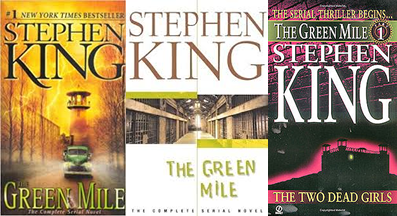
November 20, 1932 – Cold Mountain Penitentiary, Louisiana.
John Coffey was put to death in the electric chair (Old Sparky) for rape-murders he did not commit.
He walked the forty yards of the green linoleum passageway (“the color of tired old limes”) with a kind of sympathy for his executioners.
Many years following the carrying out of that death penalty, Paul Edgecombe, the-then superintendent of E Block and the head of the execution team – “the bull-goose screw” – feels compelled to set down what he experienced in the presence of John Coffey. That presence, that experience, had something – much, really – of the preternatural.
Paul Edgecombe’s memoir is composed years afterward, from the nursing home which he likens to “a death row.” From his memoir, we learn of the executioners’ regimens — and we learn about the electric chair’s habitat, and its features (anthropomorphized): the embracing straps, the jaw-like clamps, the metal cap and brine-soaked sponge (for conductivity); the stout oak legs, and the broad oak arms that absorbed the terrorized sweat of the condemned.
We are given details of Old Sparky’s coming to life as it delivers death. And for those so seated, we get a sense of what it meant to know that you were about to die with your knees bent.
And we learn about a man wrongly condemned.
John Coffey
To assure an uneventful delivery from courtroom to Cold Mountain, Coffey was shackled round-and-about, with “more chains on him than Scrooge saw on Marley’s ghost.”
Coffey was the biggest man the uniformed keepers had ever seen: He “looked like he could have snapped the chains that held him as easily as you might snap the ribbons on a Christmas present.”
Paul Edgecombe looked him up and down, “mostly to register his height as a fact and not an optical illusion.”
As if by stark contrast, the massive Coffey was placid, impassive. He seemed not to register where he was being taken, and thus gave the impression that he was “the world’s biggest stopped clock.”
The induction Q & A furthered that impression. But to good effect, Stephen King endowed Coffey with a voice that resembled “a deep and quiet rumble,” which reminded Edgecombe of “a freshly-tuned tractor engine.” Coffey’s utterly unthreatening deepness seemed to fit the huge man’s “peaceful absence.”
Coffey arrived as a wholly solitary soul, with no connections via friends or relations. With scarcely a trace of rancor or even resentment, Coffey explained that his defense lawyer “was give to me on loan. I believe I’ve seen the back end of him.”
To make him even more of a mystery, and a figure of genuine and kind curiosity, Stephen King had him unable to tie shoe laces; and had him confess to being afraid of the dark. Coffey’s only request was that, at bedtime lights-out, a light be left on in his cell.
Cell-block counseling and counselors
E Block residents often had a variety of temperaments. The common denominator: apprehension. They had all been sentenced to die in the electric chair.
The guards had to be alert and sensitive to any hint of a disruption or disturbance. Yelling, hickory batons, and straight-jacket restraints were the last resort. Edgecombe likened the desired atmosphere to that of a hospital’s intensive-care ward. An abiding quiet was the ideal.
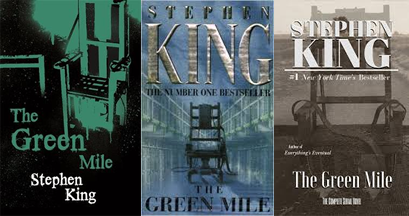
When communication was needed, it had to be directed and phrased so that the agitated condemned-man would not snap. With “total loss” impending, and then imminent, uncontained outbursts could be threatening to all.
The guards had to be especially aware of the evening’s “long thoughts that start to steal over the minds of the condemned, again. In their eyes, you could see it, like afternoon shadows.”
Paul Edgecombe informs us that on E Block, “Talking was our biggest, most important job.”
The mouse on The Mile
A mouse had never been seen on E Block, before or thereafter.
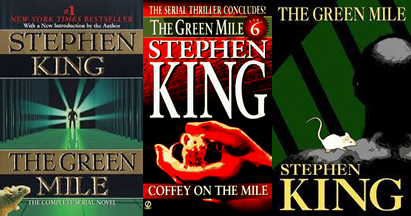
The mouse’s “bright little oil-drop eyes” seemed “interested and intelligent.” The guards were taken by the way he looked at them, “as if he wanted to remember our faces if we met again.” There was something human in his manners: “He curled his tail around his paws as prim as an old lady setting her skirts.”
The guards were fascinated, even transfixed, by the way he separated the contents of a sandwich, and then proceeded to eat select morsels “as neat as a parson at a parish house supper.”
With familiarity, they saw him proceed “as deliberately and knowingly as a man tucking into a good roast-beef dinner in his favorite restaurant.” He turned a bit of corned beef in his forepaws, “occasionally turning it and glancing at it, as if in admiration and appreciation.”
He’d munch away on a mint, “just as neatly as an old lady at an afternoon tea-party.”
Via the novel’s memoir writer, the rest of us receive tips about memoir writing
Until he started writing his memoir, Paul Edgecombe hadn’t realized how important the mouse was to his thinking about the condemned and his role in their meeting their maker: “I don’t think that ever occurred to me, not to my conscious mind, anyway, until I began to write and remember.”
Through Paul Edgecombe, Stephen King informs us of the challenges to excavating, mining, unearthing, examining, and setting down deep memories; the work and struggle required in revealing one’s self, after penetrating contemplation: “I didn’t realize how many doors the act of writing unlocks, as if my Dad’s old fountain pen wasn’t really a pen at all, but some strange variety of skeleton key.”
“Writing is a special and rather terrifying form of remembrance…. I believe the combination of pencil and memory creates a kind of practical magic, and magic is dangerous.” The remembrance has the past “doubling over the present.” And yet there is another danger, another apprehension: the fear that before remembrance is well-recorded, the memory will evaporate, “go white for a bit, like film that’s been left out in the sun.”
The way out, of this life
Through Paul Edgecombe, Stephen King reminds us that “we each owe a death, there are no exceptions.”
For Paul Edgecombe, late at night, lying in his bed in the “death row” of a nursing home, he listens to “the dank and hopeless sound of infirm men and women coughing their courses deeper into old age” – and deeper still into infirmity and lapse.
Edgecombe considers all the dire and terminal afflictions that “have swerved” to avoid him, “the way a man driving a car swerves to avoid a deer or a raccoon in the road.”
Perhaps he has been spared, given a reprieve, a commutation – a stay of execution – of a sort: spared so that he would set down what happened at Cold Mountain’s Green Mile those many years before.
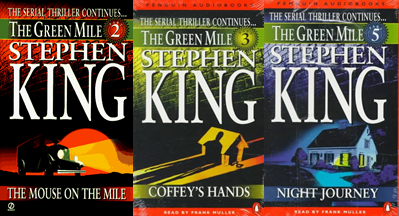
Perhaps Stephen King meant to have readers consider what they might set down, before the final bill is paid.
Stephen King on Horror
In his 1981 essay for Playboy – “Why We Crave Horror Movies” – King explained that many (many, in truth, as corroborated by book-sale and movie-box-office evidence) want to have their emotional and psychological tolerance for gore tested, and tested again, and again. They “dare the nightmare,” because, explained King, though not yet consigned to asylums, seekers of horror are still, in a way, mentally ill. These folks test their fear threshold – again, and again…
There is, he rightly pointed out, the fascination of seeing others menaced – and killed, in most gruesome ways.
In the weeks leading up to Halloween, I have had community college English Comp students read and comment on that essay. For the most part, the responses were unenlightening — banal.
By contrast, while there were many devotees of horror stories among the inmate-students I taught at a Connecticut prison and at a New York State max, quite a number recoiled at the graphic and random nature of so much contrived mayhem. They had seen enough – and had caused enough – to find filmmakers to be exploiting and tantalizing (and trivializing) what should be abhorred. Several found the depictions to be reminders of the callousness, and depravity, they had been trying to put behind them.
They weren’t looking for a curriculum of fairy tales or super-hero fantasy exploits. These select inmates (who were qualifying for community college course credits) were quite disposed to receiving guidance about coming to terms with the horror they had done and had visited on a victim’s family – and their own.
Stephen King on Writing
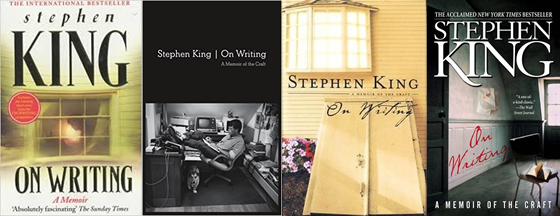
That guidance was provided, to some extent, via excerpts from and my synopses of chapters from King’s On Writing: A Memoir of the Craft. The selections worked well in a number of English Comp and undergrad Journalism courses. All these students knew several movies based on King’s novels, so they were slightly more disposed to learning what he had to say about the craft.
But, again, it was the incarcerated students — with their very limited “tool boxes” (no computers) — who found inspiration and guidance, and put the advisories to good use.
Those “tool boxes,” as King described them, are all the experiences, exposures, recollections, observations, sensations, learning and vocabulary that each of us has acquired.
Not surprisingly, the inmate-students had out-of-the-ordinary “tool boxes” – and these several dozens (from out of the hundreds on their cell blocks) were disposed to reaching into those “tool boxes.” And still fewer had no fear in reaching into those “tool boxes” again and again.
To my delight, many relished the challenge of spotting similes and recognizing metaphors (our treasure hunts). They derived satisfaction in discussing the import of those “finds.”
Not surprisingly, The Green Mile prompted essays about penitentiary regimens, the conduct of corrections officers, Miranda warnings, admissions, self-incrimination, prosecutions of those of lesser mental capability, ineffective assistance of defense counsel, and, of course, the death penalty.
Paul Edgecombe’s views prompted discourse: In his memoir, Edgecombe wrote that there was only one time that he ever questioned “the rightness of his job.” He also added this caveat, this disclaimer: “I’m not trying to say anything about right or wrong here, but only to tell how it was.”

Life Sentences
Through Paul Edgecombe, Stephen King had taken the inmates into his confidence; he made them confidantes — and, ironically, colleagues. Edgecombe’s memoir-writing struggles in setting down his recollections helped lessen the struggles of a number of inmate-students who appreciated those soul-baring reflections and admissions. Penned when he was “incarcerated” in an end-of-days nursing home, Edgecombe’s revealings became gospel.
“Time here is like a weak acid that erases first memory and then the desire to go on living…. Some of the memories are awful, but I can feel them sharpening my mind and my awareness the way a knife sharpens a pencil, and that makes the pain worthwhile.”
That awful, painful, sharpening of mind and awareness is part of many inmates’ sentences.
“Atonement was powerful; it was the lock on the door you closed against the past.”
Although I’m still struggling with Edgecombe’s atonement metaphor, a number of inmate-students took to it: They wrote of regret and remorse – for their own misdeeds and for the way the criminal justice system took account of those misdeeds.
Interestingly, for many of the inmate-students (a number of whom had converted to Islam) John Coffey’s initials registered as a tribute to a special someone who was wrongly accused and convicted, and died for others’ misdeeds.
When The Green Mile was published in book form, following its serialization, and when the movie was released (in 1999), reviewers and critics did indeed speculate on the significance of John Coffey’s initials, and King’s intentions.
Without making self-pitying, self-righteous, or exculpatory comparisons to the “crosses” they have to bear, the inmate-students took heart that the trial, conviction, and execution of John Coffey, for crimes he did not commit, weighed on Paul Edgecombe.
For his atonement, they commuted Edgecombe’s guilt and pardoned him. They took his sentences on appeal, and, in their own handwriting, fashioned distinctive appellate reviews. In ancient cursive and awkward block letters, they committed those briefs to sheets of lined paper.